
 |
State and Regional EconomicDevelopments in CaliforniaPart III |
The San Francisco Bay Area is the second largest economic region in the state, accounting for over one-fifth of California's total population. As shown in Figure 15, the region includes nine counties, ranging from Santa Clara in the south to Sonoma and Napa in the north. The majority of workers and population are in three metropolitan areas: (1) Santa Clara County, which is home to most of the Silicon Valley; (2) the San Francisco MSA (which includes San Francisco, Marin, and San Mateo Counties); and (3) the Oakland MSA (which includes Alameda and Contra Costa Counties).
San Francisco Bay Area Economic Region--Selected Characteristics

| Key Demographic and Economic Data | |||||
| County/Area | Population | 1996 Per Capita Personal Income | Unemployment Rate June 1998 | ||
| 7/1/90 | 1/1/98 | Percent Change | |||
| Alameda/Contra Costa | 2,092,400 | 2,308,800 | 10.3% | $29,842 | 3.9% |
| Napa/Solano | 455,400 | 506,900 | 11.3 | 23,267 | 5.1 |
| San Francisco/San Mateo/Marin | 1,609,500 | 1,750,900 | 8.8 | 39,746 | 3.0 |
| Santa Clara | 1,504,400 | 1,689,900 | 12.3 | 35,395 | 3.0 |
| Sonoma | 390,300 | 437,100 | 12.0 | 27,353 | 3.3 |
| Recent Employment Trends | ||||||
| County/Area | Nonfarm Employment 1st Half 1998 | Percent Change | ||||
| 1994 | 1995 | 1996 | 1997 | 1998 | ||
| Alameda/Contra Costa | 967,817 | 0.2% | 1.9% | 2.0% | 3.6% | 3.0% |
| Napa/Solano | 154,167 | -0.3 | 0.3 | 1.8 | 3.5 | 4.7 |
| San Francisco/San Mateo/Marin | 995,733 | -0.6 | 0.8 | 3.4 | 3.9 | 2.2 |
| Santa Clara | 951,800 | 0.3 | 2.7 | 6.5 | 5.0 | 4.3 |
| Sonoma | 168,933 | 1.7 | 1.6 | 4.7 | 5.2 | 3.8 |
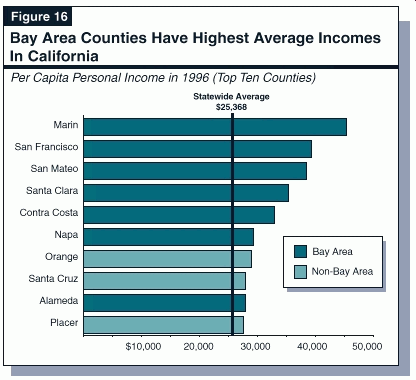
The region is home to Silicon Valley (which is mostly located within Santa Clara County), and thus has a large number of workers employed in high technology-related manufacturing and services industries. It also has a large number of jobs in varied services industries relating to engineering, management consulting, and law. It is a major center for banking and retail trade, and it has a large number of workers employed in tourism-related and international trade-related businesses. The Bay Area is also home to a number of newly emerging industries such as biotechnology and multimedia.
How Have Bay Area Economies Performed in the 1990s? As shown in Figure 17, the recession had a significant impact on the San Francisco MSA. This was due to losses in its banking, retail-trade-related, and tourism-related industries. The downturn had more modest impacts on the remainder of the Bay Area.
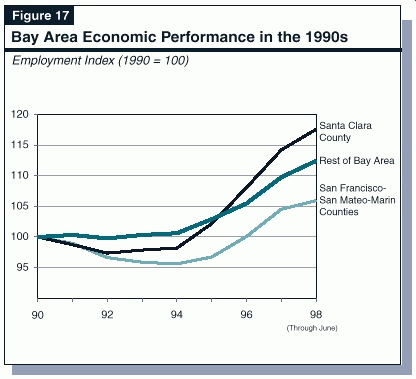
Beginning in 1995, the Santa Clara MSA experienced dramatic job increases, and San Francisco's MSA saw healthy job growth. Employment in the East Bay Counties also turned upward, but the rate of growth lagged somewhat in the early stages of the current economic expansion. Over the past two years, all counties within the Bay Area experienced healthy economic growth.
Has Been Hottest Economy in the State. Santa Clara County is the state's high technology capital, with nearly one-fourth of its workforce employed in manufacturing and services industries related to the design and production of computers, electronics, and software. The region has experienced booming economic conditions in recent years, characterized by dramatic increases in employment, income, consumer spending, business investment, new business startups, and construction activity. Total wage and salary employment in the area has increased by an average rate of 5.5 percent per year from early 1995 through early 1998, or more than double the statewide average.
The importance of the high technology sector to the Santa Clara area's overall economic performance is shown in Figure 18 (see page 24), which compares its annual percentage changes in high technology wage and salary employment to its annual changes in total wage and salary employment. The figure shows that the downturn in total employment mirrored the decline in high technology employment in the early 1990s. Likewise, more recently, the major gains in the high technology sector have boosted the region's overall job growth.
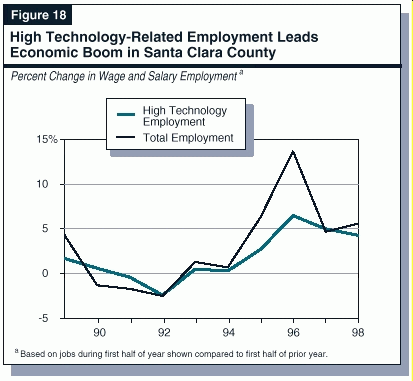
Given the importance of high technology industries to Santa Clara's overall economy, the future performance of businesses in this sector is an important factor in the county's near-term outlook. Current signs point to a significant slowdown in the high technology sector, which will likely impact the subregion's overall economy. Manufacturers of computers and computer-related components are currently facing intense competition in several markets, especially in the areas of computer memory chips, where overproduction and slackening sales have led to significant price declines. This situation is being exacerbated by slowing demand from Japan and other Asian countries, due to the economic problems in these countries. In recent months, several major California-based computer companies have announced profit declines, production cutbacks, hiring freezes, and worker furloughs. While the weakness on the "hardware" side of the industry is being partly offset by continued strength in software development and production, the overall outlook for high technology industries is for slower growth in the coming year.
Over the longer term, the Santa Clara region faces challenges related to limited availability of land for both future business expansions and new housing construction. Vacancy rates are near all-time lows, and land prices have been bid up to historic highs in recent years. For example, the median price of an existing home in the Santa Clara MSA has jumped from $250,000 to $380,000 during the past two years alone, and now stands 80 percent above the statewide average. At some point, these high prices could affect the ability of firms in the region to expand capacity and attract new workers.
The combination of these near-term and long-term factors suggests that there will be significant economic slowing in the Silicon Valley relative to its recent rapid pace of growth--and indeed, recent employment reports have indicated some slowing within the region. However, we also expect the region to remain a key California economic leader in the years ahead.
The San Francisco MSA is the highest income, highest cost region of the state. Key elements of the San Francisco MSA's economy include tourism, professional services, international trade, and finance. The San Francisco area also has a burgeoning multimedia industry.
Recent Job Growth Has Been Uncharacteristically Strong. After contracting by nearly 5 percent between 1990 and 1994, the San Francisco MSA's economy turned upward in 1994, and accelerated sharply beginning in 1995. For example, wage and salary employment registered a 3.9 percent rise between 1996 and 1997, before moderating to a 2.2 percent increase over the past year. These gains have been led by rising international trade activity, high levels of tourism and convention-related spending, and growth in business and professional services jobs. Even after accounting for the slowdown over the past year, the recent job performance has been quite strong, given that the San Francisco economy is considered to be a "mature" one. (That is, it is characterized by little unused land for population growth and further development.) Unemployment in the San Francisco MSA had dropped to 3 percent as of mid-1998among the lowest levels in the state.
Although the East Bay and North Bay Counties in the overall San Francisco Bay Area region experienced only a
modest economic downturn in the early 1990s, growth in these areas lagged during the early stages of the current economic expansion. This is partly due to the
closure of the Alameda Naval Air Station and the Mare Island Naval Shipyard, which had employed a large number of civilian personnel. However,
employment growth in the East Bay accelerated in 1997 (see Figure 19), reflecting expansion in various service industries (including biotechnology, business
services, and management consulting), as well as growth in international trade-related industries. There are also signs that growth in high technology industries
in the Silicon Valley is beginning to "spill over" into East Bay subareas, including Fremont, Pleasanton, and Livermore.
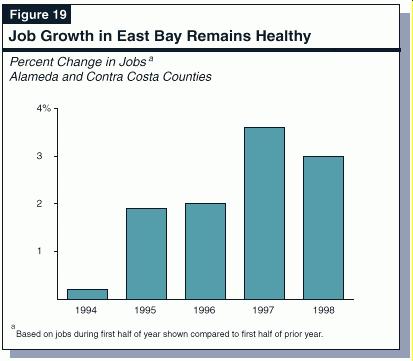
The outlook for the San Francisco Bay Area economic region is for moderate growth. The Santa Clara and San Francisco MSAs are likely to experience slower growth relative to recent years, while the East Bay and North Bay communities are likely to experience continued moderate expansion.
The Central Valley region is the third largest economically in the state, with about 5.5 million population and 2.1 million jobs in 1998. As indicated in Figure 20, the largest subregion within the Central Valley is the Sacramento MSA (which includes Sacramento, Placer, and El Dorado Counties). Other major subareas within the region include Fresno, Kern, San Joaquin, and Stanislaus Counties. Outside of Sacramento, the Central Valley region has somewhat below-average per-capita incomes and high unemployment relative to other areas of the state. This partly reflects the large number of relatively low-paying seasonal jobs in agriculture and food processing industries in the region.
Central Valley Economic Region--Selected Characteristics
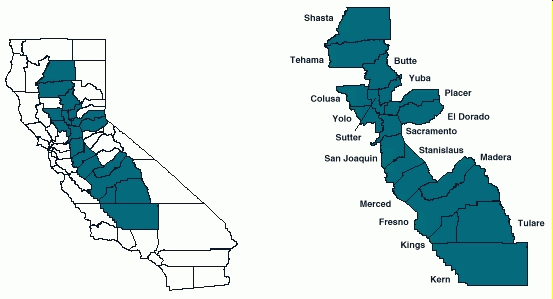
| Key Demographic and Economic Data | |||||
| County | Population | 1996 Per Capita Personal Income | Unemployment Rate June 1998 | ||
| 7/1/90 | 1/1/98 | Percent Change | |||
| Butte | 183,100 | 201,600 | 10.1% | $19,084 | 8.8% |
| Colusa | 16,400 | 18,550 | 13.1 | 20,419 | 14.2 |
| Fresno/Madera | 763,100 | 901,100 | 10.1 | 18,727 | 13.2 |
| Kern | 549,600 | 639,800 | 16.4 | 17,810 | 10.9 |
| Kings | 102,300 | 122,800 | 20.0 | 14,553 | 12.1 |
| Merced | 180,200 | 204,400 | 13.4 | 17,064 | 14.8 |
| Sacramento/Placer/ El Dorado | 1,351,500 | 1,525,300 | 12.9 | 24,444 | 5.0 |
| San Joaquin | 483,800 | 545,200 | 12.7 | 19,531 | 10.5 |
| Shasta | 148,600 | 165,000 | 11.0 | 20,144 | 8.8 |
| Stanislaus | 375,200 | 427,600 | 14.0 | 18,953 | 12.9 |
| Sutter/Yuba | 123,800 | 138,200 | 11.6 | 17,739 | 14.6 |
| Tehama | 49,900 | 55,400 | 11.0 | 16,061 | 9.2 |
| Tulare | 314,000 | 360,400 | 14.8 | 16,905 | 13.5 |
| Yolo | 141,500 | 156,800 | 10.8 | 22,747 | 4.6 |
| Recent Employment Trends | ||||||
| County | Nonfarm Employment 1st Half 1998 | Percent Change | ||||
| 1994 | 1995 | 1996 | 1997 | 1998 | ||
| Butte | 66,083 | 3.0% | 1.3% | 2.8% | 3.9% | 2.9% |
| Colusa | 4,353 | 1.1 | 0.7 | 2.2 | 2.5 | -4.6 |
| Fresno/Madera | 276,150 | 1.4 | 2.7 | 2.2 | 1.3 | 1.8 |
| Kern | 182,017 | 0.0 | 0.9 | 1.3 | 3.0 | 1.6 |
| Kings | 28,153 | 5.1 | 3.5 | 2.0 | 2.9 | 6.7 |
| Merced | 49,717 | 1.9 | -2.9 | 0.4 | 2.8 | 3.0 |
| Sacramento/Placer/El Dorado | 633,383 | 2.3 | 3.1 | 3.2 | 2.9 | 2.7 |
| San Joaquin | 166,867 | 0.1 | 2.2 | 1.4 | 2.6 | 1.8 |
| Shasta | 54,883 | 0.5 | 1.4 | 3.1 | 2.2 | 0.8 |
| Stanislaus | 133,833 | 0.6 | 1.2 | 3.0 | 3.7 | 3.6 |
| Sutter/Yuba | 34,017 | 1.8 | 0.1 | 1.3 | 2.7 | 3.9 |
| Tehama | 12,890 | 1.2 | 2.4 | 0.8 | 0.8 | 1.9 |
| Tulare | 91,017 | 1.6 | 1.8 | -0.4 | 1.8 | 2.5 |
| Yolo | 77,917 | 5.3 | 1.8 | 1.7 | -0.1 | 2.1 |
Agriculture has historically been the leading industry of the Central Valley, accounting for one-in-nine jobs in the region as a whole and one-in-six in the counties outside of Sacramento. When industries related to agricultural production are counted as well, such as agricultural food processing and service/supply industries, agriculture accounts directly and indirectly for up to one-third of the jobs in some Central Valley subareas. Figure 21 illustrates the Central Valley's dominance in agricultural production.
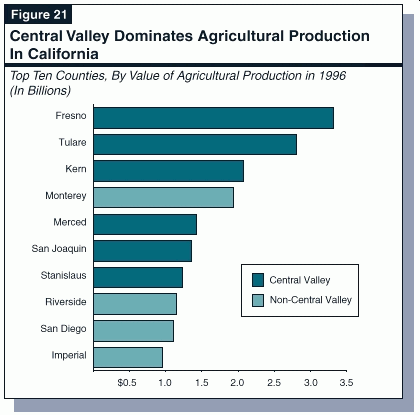
In recent years, much of the Central Valley's economic growth has come from the industrial diversification of its major economic areas, largely resulting from the migration of people and firms from high-cost coastal regions of the state. For example, Sacramento has experienced significant increases in employment in high technology industries, due to the expansion of several major computer and electronics firms into its metropolitan area. Job growth within the Central Valley has also occurred as a result of business expansions in various light manufacturing, wholesaling, and distribution industries, as well as the location of divisions of various insurance and financial services companies. Finally, San Joaquin, Stanislaus, and Solano Counties have seen significant population increases associated with workers who commute to the Bay Area, who are seeking affordable housing and various other lifestyle-related factors that can still be found in the Central Valley.
Although the migration of people and firms to the Central Valley slowed in the early 1990s, the region as a whole maintained positive economic growth through
the state's major recession. In addition, the Central Valley remained one of the faster growing regions in California during the early stages of the state's current
economic expansion. Over the past two years, however, the region's economic performance has lagged the rest of the state, (see Figure 22).
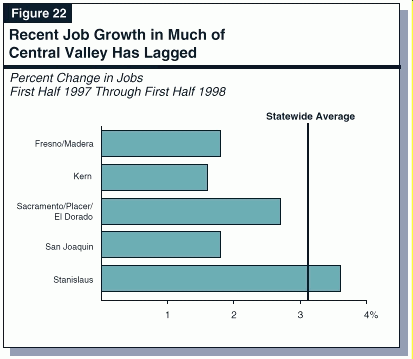
The Sacramento MSA. The Sacramento MSA has been the Central Valley's fastest-growing major subregion since the beginning of the current economic expansion. Over the past year, jobs in this area increased by 2.7 percent. Sacramento's private economy (that is, excluding government-related employment) increased by 3.5 percent, reflecting rapid growth in varied manufacturing, wholesale trade, transportation, and construction industries. In contrast, the subregion's government sectorwhich employs about one-in-four workersincreased by just 0.6 percent, reflecting such factors as cutbacks at McClellan Air Force Base and relatively level state government employment.
In the near term, continued job cutbacks related to military base closures and the slowdown in high technology employment will hold down overall job growth. Over the longer term, however, the subregion should be one of the faster growing regions of the state, reflecting continued expansion of population and businesses into the area.
Other Central Valley Areas. Growth in other Central Valley metropolitan regions has been somewhat mixed during the past year. For example, the Stanislaus MSA has experienced relatively strong growth, reflecting continued migration of people and businesses into the region from the Bay Area. However, other metropolitan areassuch as the San Joaquin, Fresno/Madera, and Kern MSAshave been growing at more modest rates.
The Central Valley is anticipated to be among California's faster-growing regions over the longer term, as people and firms continue to migrate from coastal
areas into the various metropolitan areas throughout the valley.
With high and rising home costs and other capacity constraints in the Bay Area, a significant amount of the underlying growth in that region is likely to spill over into the Central Valley in the years ahead. A key issue for the Central Valley will involve land use decisions relating to tradeoffs between agricultural, industrial, commercial, and residential growth.
As shown in Figure 23, the Central Coast economic region includes the counties of Santa Barbara, San Luis Obispo, Monterey, San Benito, and Santa Cruz. Together, these counties account for about 1.3 million of the state's population and about one-half million of its total employment base. The main industries in the region include: tourism; computer, electronics and software-related services (which are mostly centered in the Santa Barbara and Santa Cruz areas); aerospace (which is centered in Santa Barbara County adjacent to Vandenberg Air Force Base); and agriculture (which is centered in Monterey County, the fourth largest agricultural county in California).
Central Coast Economic Region--Selected Characteristics
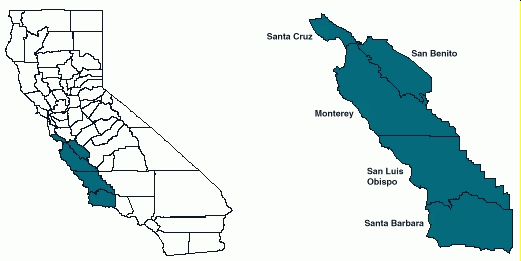
| Key Demographic and Economic Data | |||||
| County | Population | 1996 Per Capita Personal Income | Unemployment Rate June 1998 | ||
| 7/1/90 | 1/1/98 | Percent Change | |||
| Monterey | 357,400 | 386,200 | 8.1% | $25,032 | 7.6% |
| San Benito | 37,000 | 46,600 | 25.9 | 18,831 | 10.5 |
| San Luis Obispo | 218,000 | 239,000 | 9.6 | 21,483 | 4.0 |
| Santa Barbara | 370,900 | 405,500 | 9.3 | 27,003 | 3.7 |
| Santa Cruz | 230,400 | 250,200 | 8.6 | 27,896 | 5.1 |
| Recent Employment Trends | ||||||
| County | Nonfarm Employment 1st Half 1998 | Percent Change | ||||
| 1994 | 1995 | 1996 | 1997 | 1998 | ||
| Monterey | 118,483 | -0.1% | -0.4% | 4.6% | 3.5% | 2.2% |
| San Benito | 11,688 | -0.3 | 8.1 | 9.1 | 12.9 | 3.1 |
| San Luis Obispo | 84,417 | 3.2 | 4.8 | 3.5 | 2.8 | 3.9 |
| Santa Barbara | 152,333 | 0.2 | 0.2 | 0.4 | 3.9 | 1.4 |
| Santa Cruz | 93,817 | 0.8 | 1.9 | 2.1 | 3.5 | 4.2 |
The early 1990s' recession resulted in modest employment reductions in various manufacturing, retail trade, tourism-related, services, finance, and construction industries in the Central Coast region. Also, defense-related reductions had a significant adverse impact on the region. For example, Monterey County was affected by the closure of the Fort Ord Army Base, while cutbacks by defense contractors lowered aerospace employment in Santa Barbara County. Overall, wage and salary employment in the Central Coast region fell by about 3 percent between 1990 and 1993.
In more recent years, the Central Coast has expanded in line with California's overall economy. Employment growth over the past year has ranged from 1.4 percent (in Santa Barbara County) to 4.2 percent (in Santa Cruz County), reflecting increases in services, trade, and manufacturing industries.
The remaining 20 counties of California not included within the four major economic regions discussed above account for a large share of the land mass of
California, but only a small share of the state's population and employment. As shown in Figure 24, the largest of these counties are Mendocino, Imperial,
Humboldt, and Nevada.
Population and employment in these rural areas have been increasing at a moderate rate, and we expect this trend to continue into the foreseeable future.
Rest-of-State Economic Region--Selected Characteristics
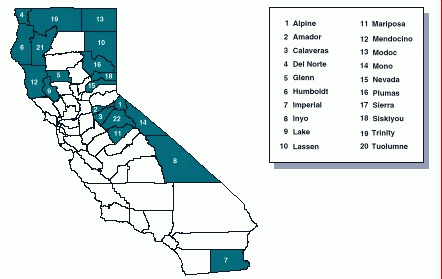
| Key Demographic and Economic Data | |||||
| County | Population | 1996 Per Capita Personal Income | Unemployment Rate June 1998 | ||
| 7/1/90 | 1/1/98 | Percent Change | |||
| Alpine | 1,100 | 1,200 | 9.1% | $23,487 | 16.0% |
| Amador | 30,300 | 33,700 | 11.2 | 18,702 | 5.2 |
| Calaveras | 32,350 | 38,350 | 18.5 | 17,929 | 8.5 |
| Del Norte | 24,150 | 28,900 | 19.7 | 14,482 | 9.4 |
| Glenn | 24,900 | 26,950 | 8.2 | 17,727 | 13.3 |
| Humboldt | 119,600 | 127,700 | 6.8 | 19,606 | 6.7 |
| Imperial | 110,800 | 142,100 | 28.2 | 14,394 | 23.4 |
| Inyo | 18,250 | 18,500 | 1.4 | 21,382 | 6.9 |
| Lake | 51,000 | 55,100 | 8.0 | 19,286 | 9.9 |
| Lassen | 27,700 | 34,150 | 23.3 | 14,881 | 7.9 |
| Mariposa | 14,550 | 16,150 | 11.0 | 18,485 | 6.3 |
| Mendocino | 81,000 | 86,900 | 7.3 | 20,750 | 7.2 |
| Modoc | 9,725 | 10,150 | 4.4 | 14,743 | 9.6 |
| Mono | 10,050 | 10,600 | 5.5 | 20,682 | 12.6 |
| Nevada | 79,100 | 88,800 | 12.3 | 21,705 | 5.9 |
| Plumas | 19,750 | 20,600 | 4.3 | 20,788 | 7.4 |
| Sierra | 3,320 | 3,360 | 1.2 | 19,344 | 8.8 |
| Siskiyou | 43,550 | 44,700 | 2.6 | 18,751 | 11.1 |
| Trinity | 13,000 | 13,250 | 1.9 | 16,499 | 10.7 |
| Tuolumne | 48,650 | 52,800 | 8.5 | 17,817 | 6.7 |
| Recent Employment Trends | ||||||
| County | Nonfarm Employment 1st Half 1998 | Percent Change | ||||
| 1994 | 1995 | 1996 | 1997 | 1998 | ||
| Alpine | 1,195 | 0.4% | 27.9% | -5.1% | -0.4% | 6.9% |
| Amador | 9,630 | -1.7 | 3.1 | 4.3 | 1.9 | 0.1 |
| Calaveras | 7,175 | -1.4 | -3.5 | 3.7 | 3.5 | -0.5 |
| Del Norte | 7,392 | 2.3 | 1.0 | 4.1 | 2.3 | 0.1 |
| Glenn | 6,475 | 2.3 | 2.8 | -1.3 | 3.9 | 2.5 |
| Humboldt | 48,433 | 1.1 | 2.3 | 3.1 | 1.3 | 1.7 |
| Imperial | 35,617 | 3.4 | -1.1 | -0.2 | 1.9 | 1.6 |
| Inyo | 7,548 | -0.3 | 3.0 | 3.8 | 3.3 | 2.7 |
| Lake | 11,937 | 4.7 | 6.1 | 1.8 | -2.6 | 2.4 |
| Lassen | 9,430 | 1.5 | -1.5 | 10.5 | 2.9 | -1.0 |
| Mariposa | 4,218 | 0.3 | 2.9 | 4.5 | 13.4 | -2.7 |
| Mendocino | 28,515 | 4.0 | 1.8 | 5.8 | 0.6 | 1.5 |
| Modoc | 2,412 | 5.2 | -0.1 | 2.1 | -3.3 | 4.3 |
| Mono | 5,915 | -3.5 | 2.0 | 0.3 | 2.3 | 4.0 |
| Nevada | 23,650 | 0.8 | -0.3 | 1.2 | 3.0 | 1.4 |
| Plumas | 6,907 | 0.6 | -0.1 | 4.6 | 2.6 | 4.6 |
| Sierra | 918 | -1.4 | 3.7 | -0.9 | -0.2 | -1.4 |
| Siskiyou | 12,955 | 1.8 | -0.7 | 0.9 | 2.2 | 0.2 |
| Trinity | 3,278 | 4.1 | 0.5 | 0.6 | 1.1 | 6.7 |
| Tuolumne | 14,890 | 4.5 | -1.5 | -2.8 | 4.4 | 4.6 |
During California's deep and prolonged 1990s' recession, concerns emerged about whether California's growth prospects had permanently deteriorated. The healthy and diversified economic growth that has emerged over the past two years indicates that the state remains economically competitive with other geographic regions of the country.
With this economic improvement comes a major shift in the types of challenges facing state and local policymakers. In contrast to the early 1990s, when the focus was on controlling budgetary deficits and retaining jobs and businesses in California, the main challenge in future years is likely to involve accommodating the significant demographic and economic growth that will inevitably occur over the next decade. The improving economy has already resulted in an acceleration in statewide population growth, and such higher growth trends will likely continue. The more rapid growth in the state's economy and population bring back to the forefront many of the growth-related issues and challenges which were somewhat dormant during the early 1990sissues and challenges in areas such as land use planning, education, air and water quality, water supplies, transportation, and other infrastructure.
The key challenge facing state policymakers will be to develop an appropriate mix of spending, regulatory, and tax policies that will both sustain economic growth, and address the challenges posed by such growth in the future.
Higher Education Enrollments: Is a Tidal Wave Coming? (February 1998).
Taking Advantage of New Federal Higher Education Tax Credits (February 1998).
After the Transportation Blueprint: Developing and Funding and Efficient Transportation System (March 5, 1998)
Medi-Cal Managed Care Has Not Had an Adverse Effect on Rural Health Care Clinics (March 16, 1998)
Why County Revenues Vary: State Laws and Local Condition Affecting County Finance (May 7, 1998)
California Counties A Look at Program Performance (May 1998)
A Primer on the Vehicle License Fee (June 17, 1998)
Reviews of Medi-Cal Managed Care Plans Show Disappointing Results (August 1998)
State Superfund Reauthorization Expediting Hazardous Substance Site Cleanups (August 17, 1998)
Major Features of the 1998 California Budget (August 24, 1998)
What the New Federal Act Means for California Transportation Equity Act for the 21st Century (August 26, 1998)
California Spending Plan: The Budget Act and Related Legislation (October 1998)
California's Fiscal Outlook: The LAO's Economic and Budget Projections, 1998-99 through 2000-01 (November 1998)
| Acknowledgments
This report was prepared by Brad Williams, with assistance from Robert Ingenito, and reviewed by David Vasch�. The Legislative Analyst's Office (LAO) is a nonpartisan office which provides fiscal and policy information and advice to the Legislature. |
LAO Publications
To request publications call (916) 445-2375. This report and others, as well as an E-mail subscription service, are available on the LAO's World Wide Web site at http:// www.lao.ca.gov. The LAO is located at 925 L Street, Suite 1000, Sacramento, CA 95814. |
Return to Regional Economics Part II